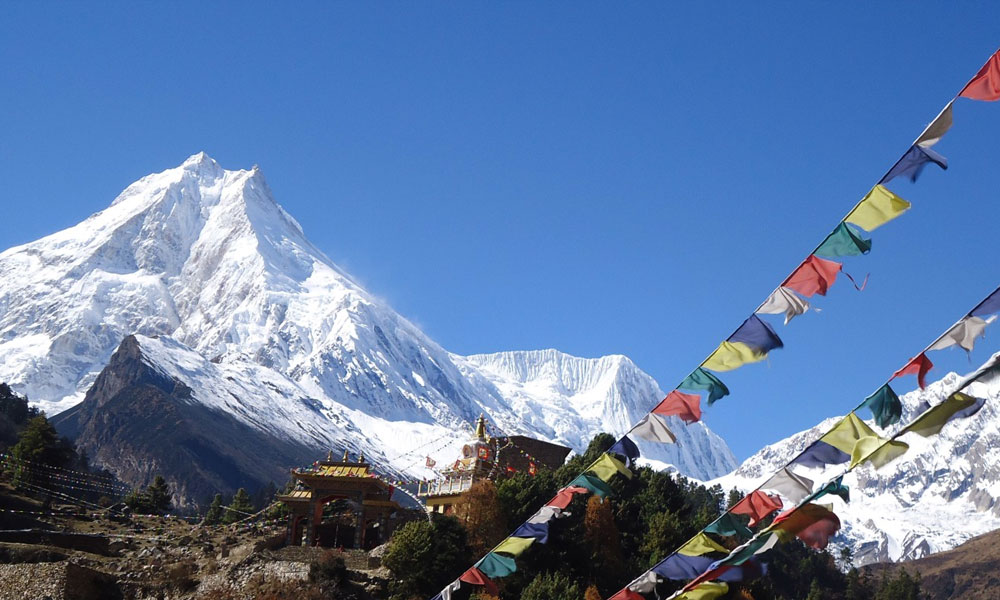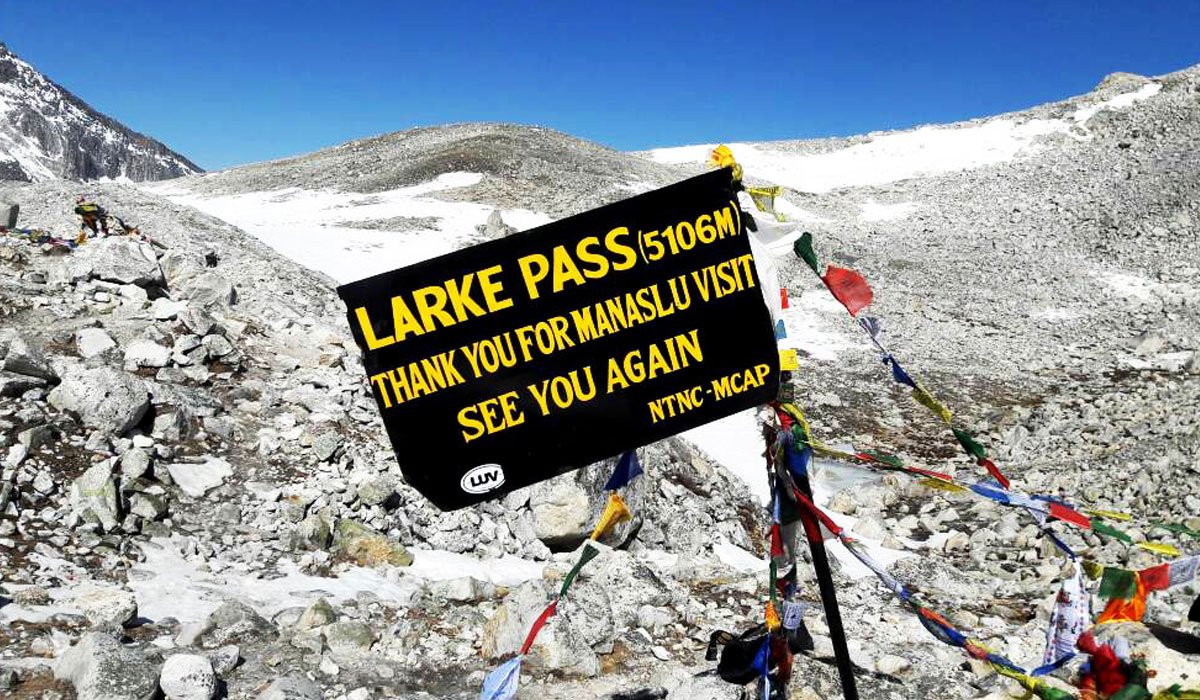The Larke Pass is one of the most intriguing high-altitude passes in Nepal. The Manaslu Circuit Trek covers up the Larke Pass, which includes hiking through breathtaking landscapes and unforgettable encounters.
Mount Manaslu, the eighth-highest mountain in the world at 8,163 meters (26,781 ft) above sea level, is the major attraction of this region. While trekkers embark on the Larke Pass Trek, they will delve into the beauty of the Manaslu Conservation Area, including the beautiful scenery of Mount Manaslu and other peaks like Himal Chuli, Gyala Himal, and Chhamjo Himal.
The ultimate destination, Larke Pass, stands at 5106 meters above sea level. And it is one of the best viewpoints of Nepal from where you can not only experience the view of the Himalayas but also the scenic sunrise and sunsets. Similarly, trek to Larke Pass is mesmerizing. The scenic hike through the diverse and vibrant settlements of Nubri ethnic groups in the Tsum Valley is worth visiting this place.
Similalry, the Buddhist landmarks, including ancient Tibetan Monasteries, Chortens, prayer flags, praying wheels, and mani walls keep your journey boosted. Here are some details you should know about Larke Pass. Read the following blog to learn more about it.
How To Reach Larke Pass?
-Wide-Spread-Himalayan-Pass-In-Nepal.jpg)
To reach Larke Pass, trekkers must embark on a Manaslu Circuit Trek. The journey begins with a scenic drive from Kathmandu to Soti Khola. The drive through black topped road first takes trekkers across the green hills and terraced fields of Dhading. It then diverts its way from Arughat Bazaar, where the next phase of the journey begins.
Upon reaching Soti Khola from Besi Sahar, trekkers must embark on a trek to Machha Khola, which takes only 4 to 5 hours. After reaching Machha Khola, trekkers will settle at a local tea house, enjoying the local dishes and shared bedroom.
From Machha Khola, trekkers have to continue their journey through the uphill trail, which is rugged and rocky. The trail passes through the Budi Gandaki Valley, and trekkers must walk aside the Budi Gandaki River that passes through several settlements, including Tatopani, Doban, Jagat, Philim, Nyak Phedi, and Deng Village.
The local settlements are rich in Buddhist culture and feature several cultural artifacts and entities, including prayer flags, praying wheels, mani walls, and chortens.
Trekkers must go alongside the Budi Gandaki River and reach Lihi, Sho, and Lho. From there, the trail stretches towards Samagaon. From Samagaon, the next destination to reach is Samdo, at 3690 meters above sea level, before reaching Larkya Bazaar. It is a small remote marketplace where you can find several tea houses to stay in and shops and stores for shopping. The final village before reaching Larke Pass is Dharmasala, which takes around 4 hours to reach Larkya Bazaar.
Larke Pass stands 5 106 meters above sea level, one of the most popular high-altitude passes. Watching the mystic mountain ranges of Manaslu, Gyala Himal, Chhamjo Himal, Himal Chuli, and many others is also one of the most intriguing viewpoints.
After the exploration of Larke Pass, trekkers will have to descend to Bimtang and Yak Kharka to continue their journey to Tilije and Dharapani. From Dharapani, trekkers can opt for a jeep ride to Kathmandu or Besi Sahar. It only takes around 5 hours to reach Kathmandu from Besi Sahar.
The Difficulty of Trek | Challenges

The difficulty level of reaching the Manaslu Larke pass is fairly challenging. It requires a high level of physical and mental preparation. The most important thing you should acknowledge is that reaching Larke Pass takes a multi-day trek from Arughat and Soti Khola. So walking through the strenuous and rugged trails all day might be very challenging for trekkers. On top of that, the average trek duration of the Manaslu Larke Pass Trek is around 5 to 6 hours daily. So walking for such a long time might be physically demanding.
Another challenging part that comes with the Larke Pass Trek is altitude. The Larke Pass is situated at 5,106 meters above sea level, which is a high-altitude location. Such high-altitude locations are prone to altitude sickness since the oxygen level is very low, and the air is depleted with high pressure. With prolonged exposure to such places, trekkers can suffer from altitude-related illnesses like HACE (High Altitude Cerebral Edema), HAPE (High Altitude Pulmonary Edema), and AMS (Acute Mountain Sickness).
Weather conditions and climate are the next factors that make this trek more challenging. Since the Larke Pass lies in the Himalayan region, the climate is unpredictable and can change within hours. Low temperatures, sharp winds, high air pressure, and rainfall/snowfall during monsoon and winter are common here. So, it's very important to prepare accordingly.
Best Time to Trek to Larke Pass

When it comes to the best time to trek to Larke Pass, it depends on various factors, such as weather, trail conditions, and personal preferences. Larke Pass, also known as Larkya La Pass, is one of Nepal's high-altitude passes located on the Manaslu Circuit. While choosing the best time to trek, trekkers must consider the best balance between favorable weather and clear trails.
If you see the trekking seasons, there are two best seasons in Nepal, Spring and Autumn. They are considered the best for some reasons; here are some of them:
Spring (March to May):
Spring Season brings a colorful vibe to the country with full-bloomed flowers and green leaves in the forests. While trekkers embark on the Larke Pass trek, they will experience the most iconic scenes on the trail with full-bloomed rhododendron and picturesque forests.
Similarly, Spring comes with stable weather conditions and moderate temperatures. The average temperature of Larke Pass during the spring is between -6 to 18 degrees Celsius.
There is less chance of rainfall or snowfall in the region, which will help in safe navigation to the destination. The trail is usually dry and crispy, which assures your safety. Moreover, the scenery is the best thing you will cherish during this trek. Since the Spring features fewer clouds in the sky and surroundings, the visibility is clear and crisp, which allows you to have picturesque views of the snow-capped peaks, green hills, valleys, and rivers.
Autumn (September to November):
Another highly recommended time for trekking to Larke Pass is during the autumn season. It is the season of festivals. Major festivals like Dashain and Tihar fall under this season, bringing various portals to delve into Nepalese culture and tradition.
Similarly, it features similar weather conditions like Spring which is clear skies with fewer clouds, allowing you to have clear views of the surroundings. Similarly, the temperature is mild and favorable, which is ideal for trekking. The average temperature of Larke Pass and its surroundings is between 12 to 15℃. However, during the late Autumn, the temperature can also drop to 0 Degrees Celsius. So it is best to prepare with your clothing, gear, and other required materials for the trek. In addition, there is very little chance of rainfall and snowfall, making it safe and convenient to walk through the remote trails of the Manaslu region.
Compared to Spring, Autumn is less crowded in the Manaslu Region, making accommodation and transportation accessible.
Despite the favorable weather conditions and scenery, trekkers still have to be prepared for the cold temperatures and altitude-related issues in high-altitude destinations like Larke Pass, Samdo, and Dharmasala. Always check the latest weather forecasts and trail conditions before embarking on your trek, and consider traveling with a reputable trekking agency or guide for safety and support.
You may also like:

